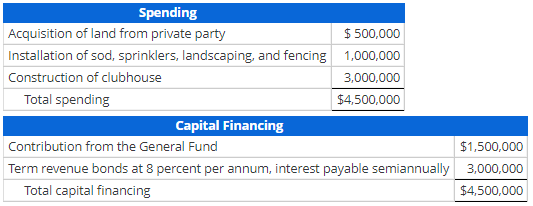
The City plans to sell the bonds on February 1, 2018. Because the bonds are a term issue, bond principal matures in full on February 1, 2028. Interest is payable each August 1 and February 1, beginning August 1, 2018. The bond covenant requires that assets equal to one-tenth of the bond principal be transferred to a restricted account within the GEF on December 31 of each year. Whitt observes a calendar fiscal year.
Simmons Design and Construction, Inc. (Simmons) has been awarded the contract to develop the golf course. Construction will commence February 15, 2018, and be completed no later than May 31, so it can open for business during June. The contract stipulates that progress billings from Simmons will be paid within 30 days of receipt, with 5 percent retainage held pending completion and acceptance of the project. The city engineer will inspect the contractor’s work and approve progress payments.
Accounting for the GEF will be done by the city’s existing accounting department (a General Fund department), which will bill the GEF for services rendered at the end of the year. To help the GEF get on its feet financially, no interfund payables will be settled in cash during 2018.
Prepare (a) journal entries (including closing entries) to record the following events and transactions for the year ended December 31, 2018, in the GEF. The corresponding entries that would be made in other funds are not required. In addition, prepare (b) the statement of net position and (c) the statement of revenues, expenses, and changes in net position for the GEF as of and for the fiscal year ending December 31, 2018.
1. January 3, 2018: Whitt Falls formally established the GEF; the fund’s first transaction was the receipt, in cash, of the capital contribution from the General Fund.
2. January 24: The city acquired the adjacent parcel of land from the private owner for the planned $500,000.
3. February 1: The revenue bonds were sold at par ($3,000,000).
4. February 15: Development of the golf course itself and construction of the clubhouse commenced.
5. March 31: Simmons submitted the first progress billing of $1,800,000. The billing was approved and set up as a construction contracts payable after deducting the 5 percent retainage. (Because of the short duration of the construction period, no construction in progress accounts will be used.) $400,000 of the amount billed represents the cost of sod, sprinklers, landscaping, and fencing (which the city classifies as “improvements other than buildings”). The balance applies to the cost of the clubhouse (“buildings”).
6. April 25: The construction contracts payable currently due Simmons was paid.
7. April 30: The second progress billing from Simmons, $1,500,000, was approved and set up as a construction contracts payable after deducting the 5 percent retainage; $600,000 applies to sod, sprinklers, landscaping, and fencing (which is now fully installed), with the remainder to the clubhouse building.
8. May 19: The construction contracts payable currently due Simmons was paid.
9. May 23: Simmons’ third and final progress billing, $700,000 (all of which represents clubhouse construction costs), was approved and set up as a construction contracts payable after deducting the 5 percent retainage.
10. May 30: The construction contracts payable currently due Simmons was paid.
11. June 1: The new golf course was formally accepted by the City (without need for “touch-up” work), and all remaining amounts due to Simmons were paid.
12. June 1: The City acquired golf course maintenance equipment by entering into a 4-year financing lease. The first lease payment of $50,000 was paid on June 2 when the equipment was delivered. The remaining lease payments of $50,000 each will occur on the first, second, and third anniversary of the first payment. Assume that the interest rate on the lease is 4 percent.
13. June 2: Inventory in the amount of $12,000 was acquired for the pro shop; the purchase created an accounts payable.
14. June 4: The course opened for business. Greens fees (charges for services) aggregated $209,000 for June. Pro shop sales (all for cash) amounted to $5,000.
15. June 30: Expenses for June were as follows. (Charge all expenses to “Operating expenses—cost of sales.”)

